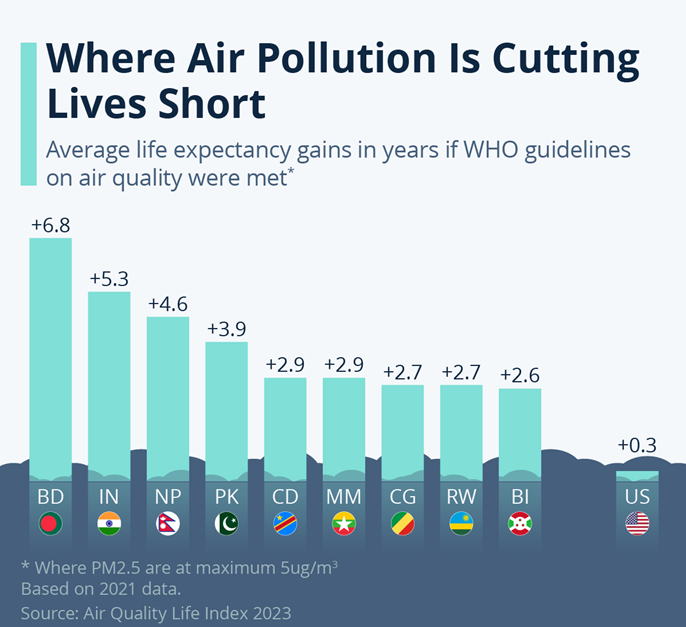NINE THINGS TO DO FOR CLEAN AIR
Relevance: GS3 – Conservation, environmental pollution and degradation, environmental impact assessment.
Why in the News?
- Three Indian cities feature among the top 10 most polluted globally, as reported by the Swiss organization IQAir. Delhi claims the unenviable first position, holding both the title of the most polluted Indian city and the highest global ranking.
- According to IQAir, Delhi’s air quality index (AQI) reached 430. This marked figure signifies a concerning level of air pollution in the city. The ban on firecrackers during Diwali was breached in various parts of Delhi.
- Current responses to air pollution tend to be fragmented, addressing symptoms rather than root causes. Measures like smog towers, dust suppression, construction bans, and odd-even restrictions offer temporary relief but lack comprehensive solutions.
Lethal Toll of Air Pollution:
- Air pollution ranks as the fifth-largest cause of death in India.
- In 2019, it caused 1.6 million premature deaths, exceeding three times the official Covid death toll during the pandemic.
- Poor air quality results in an annual economic loss of around Rs 7 lakh crore.
- This figure surpasses one-third of the total annual GST collection.
- Daily life, work, and study routines face routine disruption due to the adverse effects of air pollution.
Challenges to Air Pollution
- Complex Nature: Air pollution is a systemic issue cutting across state and regional boundaries. It involves diverse sources of emissions, affecting both rural and urban areas. Interconnected economic factors and interests contribute to the complexity.
- Rural Health: The toll on rural Indians is substantial, constituting two-thirds of premature deaths from air pollution. Despite their limited contribution to emissions, rural communities suffer disproportionately from severe air quality issues.
- Incomplete Assessment: Current evaluations overlook the comprehensive impact on the health and well-being of the population. The adverse effects extend beyond statistics, affecting the quality of life for millions of Indians.
- Governance, Financing, and Implementation Challenges: The crisis extends across a fractured system of governance, financing, and implementation. Addressing root causes requires a holistic approach to tackle the multifaceted dimensions of the problem.
- Human-Induced Problem: Acknowledging air pollution as a human-induced problem is essential. Recognizing the responsibility of those least responsible, such as children, older individuals, rural communities, and the urban poor, is crucial.
- Persistent Constraints: Population growth and urbanization pose ongoing challenges. A shift in focus is essential toward transforming production, transportation, consumption, and waste management systems
- Prioritizing Vulnerable Populations: Recognizing that vulnerable groups, including children, older individuals, rural communities, and the urban poor, have contributed the least to the problem. Prioritizing their protection is essential for sustainable and equitable solutions.
Lessons to limit Air Pollution
- Learning from Successful Models: Drawing lessons from countries that have effectively addressed air pollution is imperative. Implementing evidence-backed solutions based on successful global experiences can guide effective action.
- Global Exemplars: International cities like Beijing, Mexico City, and London successfully addressed severe air pollution through systematic changes. Delhi witnessed improvement by transitioning public transport from diesel to CNG in the 2000s.
- Coordinated Interventions: Embrace nine tightly coordinated interventions for a sustained anti-air pollution campaign. These interventions span the entire value chain, addressing emissions from production to consumption, recycling, and service delivery.
- Integrated Emission Reduction: Adopt an integrated approach to limit emissions and reduce exposure. Address sources such as coal-fired power plants, industries, brick kilns, and the burning of wood, cow dung, and garbage for cooking and heating in both rural and urban areas.
- Progress and Setbacks: Recognize progress with initiatives like the PM Ujjwala Yojana. Acknowledge recent reports indicating a slowdown in the impact of these efforts.
- Long-Term Perspective: Acknowledge that the battle against air pollution is a long-term endeavor. Sustained efforts are required to bring about lasting change in production, consumption, and waste management practices.
Practical Applications to address Air Pollution
Overcoming this challenge necessitates the establishment of cohesive cross-sectoral policies and well-coordinated governance structures from local to regional levels, coupled with effective monitoring systems, ensuring practical application rather than mere theoretical propositions.
- Addressing Crop Residue Burning:
- Shift to less water-intensive crops, adjust irrigation practices, and develop year-round markets for straw.
- Overcome challenges like livelihood imperatives, limited technology access, and economic distress of farmers.
- Affordable Green Urban Public Transport:
- Aim for universal last-mile connectivity, following models like Singapore, Hong Kong, and Chinese million-population cities.
- Shift metro systems in India to renewable power and expand metro ridership to reduce reliance on private two-wheelers and cars.
- Widespread Electrification:
- Advocate for widespread electrification in buildings, vehicles, and production processes.
- Switch to renewables to curb pollution and meet climate goals.
- Address challenges in the transport fuel switch through large investments in electric charging infrastructure and enhanced rail services.
- Regional Approach to Pollution:
- Adopt a regional or airshed approach to address pollution sources across an entire region.
- Learn from successful implementation in Los Angeles, Mexico City, and Chinese mega-urban regions.
- Overcome governance challenges and coordinate actions within urban areas and across states.
- End-to-End Construction and Waste Management:
- To reduce dust and waste released into the air and water bodies.
- Recycle materials from existing buildings to limit environmental impact.
- Tackle the challenge of construction and demolition waste, aiming for higher recycling rates.
- Legislation and Enforcement:
- Advocate for strong legislation and year-round enforcement of regulations.
- Resist dilution of environmental regulations, especially in the face of special interest group pressures.
- Rely on determined courts and an unwavering executive to ensure effective implementation.
- Citizen Mobilization for Awareness:
- Influence lifestyle choices over decades, drawing lessons from successful experiences in Los Angeles and Mexico City.
- Question the sustainability of “western” lifestyles in the Indian context, aligning with initiatives like the government’s LIFE initiative.
- Financial Commitment:
- Recognize the substantial funds needed for coordinated actions.
- Extend the precedent set by the Fifteenth Finance Commission to finance climate change and air pollution reduction interventions in the Sixteenth Finance Commission.
- Science and Technology Deployment:
- Deploy the best science and technology for real-time monitoring systems.
- Expand and enhance the System of Air Quality Forecasting and Research (SAFAR) network, managed by IIM Pune, across major cities’ airsheds for informed decision-making.
- Avoiding Piecemeal Approaches:
- Piecemeal strategies result in an annual cycle of panic and shutdowns.
- Coordinated actions are vital for addressing not only air pollution but also achieving urban climate and health goals simultaneously.
- Coordinated Implementation:
- Undertaking comprehensive measures might seem challenging, but Mexico City successfully implemented them in adverse weather conditions (1990s-2010s).
- Chinese regions also embraced integrated approaches in the 2010s, demonstrating the feasibility of collective actions.
- Renewable Power Shift:
- Acknowledge the positive step of transitioning many Indian metro systems to renewable power.
- Encourage the expansion of metro ridership and the enhancement and electrification of viable bus services to curb the surge in private two-wheelers and cars, major contributors to urban air pollution.
- Clear Choices, Timely Action:
- The key question is when decisive action will be taken to implement these strategies for a sustainable and healthier urban environment.
Source: https://indianexpress.com/article/opinion/columns/india-air-pollution-solutions-9024949/
Mains question
Discuss the efficacy of sustained policy interventions in mitigating air pollution’s impact on urban climate and public health. Give examples and propose holistic strategies. (250 words)





